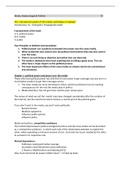Summary
FULL summary MMP 2020
- Course
- Institution
- Book
Full summary of the secondyear Communication Science course: Media, Society and Politics contains all the lecture notes, articles and the entire book (Making Sense of Media & Politics) that was covered during this course. I read and summarized everything myself. I finished the course with 9 so assu...
[Show more]




